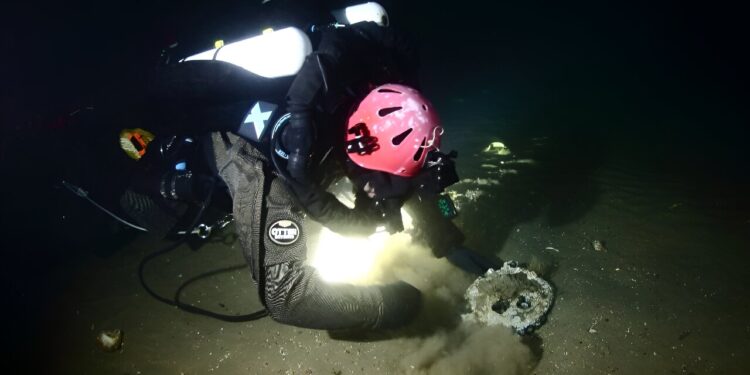An image distributed by Atlantic Wreck Salvage shows diver Joe Mazraani removing sand to reveal a “deadeye” used in the rigging of the Lyonnais’ sail.
An American diving team has discovered the wreck of a French steamship, Le Lyonnais, which sank in the Atlantic Ocean in 1856 after colliding with an American sailing ship, killing 114 people.
The Lyonnais, built in 1855 and considered at the time the most modern ship, was returning to France after completing its maiden voyage from Le Havre to New York when the disaster occurred.
Jennifer Sellitti of Atlantic Wreck Salvage, a New Jersey-based company, said a team from the dive boat D/V Tenacious discovered the wreck of the Lyonnais last month after a two-decade search.
Sellitti said divers identified the ship in waters 200 miles (320 kilometers) off New Bedford, Massachusetts, in an area known as Georges Bank. They have not revealed the exact location at this time.
“She definitely doesn’t look as good as she did before,” Sellitti told AFP. “She was really broken.”
“The North Atlantic is a very dangerous place for shipwrecks: storms, tides,” she said. “The Nantucket sandbars are notorious for quicksand that completely bury wrecks.”
Sellitti said measurements of an engine cylinder were critical to identifying the vessel.
The iron-hulled Lyonnais, fitted with sails and a steam engine, was built by a British shipbuilder, Laird & Sons, for the Franco-American Company to provide a passenger and mail service across the Atlantic.
“The 1850s marked the beginning of the transition from sail to steam,” Sellitti explains. “It was the first time that France attempted to establish a successful passenger transport line.”
The Lyonnais had sailed to New York carrying cargo and mail, she said, and was returning to Le Havre with its first passengers, most of whom were French.
This image distributed by Atlantic Wreck Salvage shows part of an engine cylinder from the Lyonnais.
Hit and run
On the night of November 2, 1856, Le Lyonnais, carrying 132 passengers and crew, collided with the Adriatic, an American barque sailing from Maine to Georgia.
Jonathan Durham, the captain of the Adriatic, said in a statement published in the November 19, 1856, edition of The New York Times that it was about 11 p.m. on a starry but “hazy” night when the Lyonnais “suddenly changed course, which rendered a collision inevitable.”
Durham said the Adriatic suffered significant damage but made it to Gloucester, Massachusetts, two days later, while the Lyonnais continued on its way.
The French ship had indeed suffered significant damage: a hole at the waterline and another lower down, probably near its coal bunkers, Sellitti said.
The ship sank a few days later. The handful of survivors were picked up by another ship.
Sellitti, whose book about the incident, “The Adriatic Affair: A Maritime Hit-and-Run Off the Coast of Nantucket,” will be released in February 2025, said the sinking of the Lyonnais was “a really significant event at the time.”
The American captain was arrested and tried in France, she said, and the collision raised a number of novel questions in maritime liability, such as what happens when a sailing ship meets a steamship at sea.
The disaster, depicted in Jules Verne’s novel “Twenty Thousand Leagues Under the Sea,” received considerable international attention, she said, but when the American Civil War broke out in 1861, “everyone stopped talking about it and turned to the Civil War.”
© 2024 AFP
Quote: Discovery of the wreck of a French liner that sank in the Atlantic in 1856 (2024, September 12) retrieved on September 12, 2024 from
This document is subject to copyright. Apart from any fair dealing for the purpose of private study or research, no part may be reproduced without written permission. The content is provided for informational purposes only.



